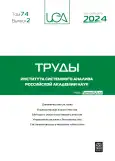On the chaotic dynamics in one variant of the diffusive predator-prey systems
- Авторлар: Evstigneev N.M.1, Karamysheva T.V.1,2
-
Мекемелер:
- Federal Research Center ’’Computer Science and Control’’ of the Russian Academy of Sciences
- Joint Institute for Nuclear Research
- Шығарылым: Том 74, № 2 (2024)
- Беттер: 11-18
- Бөлім: Dynamical Systems
- URL: https://journal-vniispk.ru/2079-0279/article/view/287114
- DOI: https://doi.org/10.14357/20790279240202
- EDN: https://elibrary.ru/EQKPQY
- ID: 287114
Дәйексөз келтіру
Толық мәтін
Аннотация
In this paper we are considering the generalization of the predator-prey model of the Lotka-Volterra type to the diffusion. The model is different from precious known diffusive Lora-Voterra systems by more complex non-linearity that corresponds to more aggressive interaction between species. This type of systems can be characterized as reaction-diffusion type of systems. In the present research we analyze the base stationary solution, its bifurcations end explore the transition to chaos by means of numerical investigation. It was detected that the series of bifurcation lead to the known cascades of bifurcations over limited cycles that coincide with the ones in Feigenbaum–Sharkovskii–Magnitskii theory. Finally, we summarize the current study and give the future work.
Авторлар туралы
N. Evstigneev
Federal Research Center ’’Computer Science and Control’’ of the Russian Academy of Sciences
Хат алмасуға жауапты Автор.
Email: evstigneevnm@yandex.ru
PhD, Lead staff scientist
Ресей, MoscowT. Karamysheva
Federal Research Center ’’Computer Science and Control’’ of the Russian Academy of Sciences; Joint Institute for Nuclear Research
Email: taisia.karamysheva@gmail.com
PhD, Chief staff engineer (0.5 rate), Senior staff scientist
Ресей, Moscow; DubnaӘдебиет тізімі
- Volterra V. Variazioni e fluttuazioni del numero d’individui in specie animali conviventi. – Societá anonima tipografica” Leonardo da Vinci”. 1927. V. 2.
- Hofbauer J., Sigmund K. Evolutionary games and population dynamics. Cambridge university press. 1998.
- Murray J.D., Murray J.D. Mathematical biology: II: spatial models and biomedical applications. – New York : springer. 2003. V. 18. P. xxvi+ 811.
- Tang L., Chen S. Traveling wave solutions for the diffusive Lotka–Volterra equations with boundary problems //Applied Mathematics and Computation. 2022. V. 413. P. 126599.
- Magnitskii N.A. Universal bifurcation chaos theory and its new applications //Mathematics. 2023. V. 11. No. 11. P. 2536.
- Hassard B.D., Kazarinoff N.D., Wan Y.H. Theory and applications of Hopf bifurcation. CUP Archive. 1981. V. 41.
- Gottlieb D., Orszag S.A. Numerical analysis of spectral methods: theory and applications. Society for Industrial and Applied Mathematics. 1977.
- Trefethen L.N. Spectral methods in MATLAB. Society for industrial and applied mathematics. 2000.
- Hoang N. On node distributions for interpolation and spectral methods // Mathematics of computation. 2016. V. 85. No. 298. P. 667-692.
- Dang-Vu H., Delcarte C. An accurate solution of the Poisson equation by the Chebyshev collocation method //Journal of Computational Physics. 1993. V. 104. No. 1. P. 211-220.
- Koto T. IMEX Runge–Kutta schemes for reaction–diffusion equations //Journal of Computational and Applied Mathematics. 2008. V. 215. No. 1. P. 182-195.
- Evstigneev N.M., Magnitskii N.A. Numerical analysis of laminar–turbulent transition by methods of chaotic dynamics //Doklady Mathematics. Pleiades Publishing. 2020. V. 101. P. 110-114.
Қосымша файлдар









